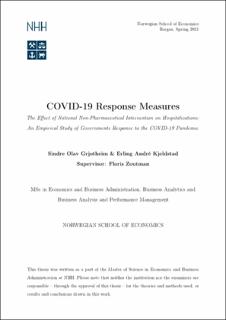COVID-19 response measures the effect of national non-pharmaceutical intervention on hospitalizations : an empirical study of governments response to the COVID-19 pandemic
Master thesis
Permanent lenke
https://hdl.handle.net/11250/2768776Utgivelsesdato
2021Metadata
Vis full innførselSamlinger
- Master Thesis [4372]
Sammendrag
Throughout this thesis we will analyze the reaction in the growth rate of COVID-19
related hospitalizations following the implementation of Non-Pharmaceutical Interventions
(NPIs), in order to estimate their effectiveness. Additionally, our thesis will investigate the
effect of specific NPIs, and the difference in NPI performance throughout the pandemic.
Although previous studies have focused on the reproduction number R, case growth, and
cumulative deaths as their dependent variable, our thesis focuses on the number of daily
COVID-19 related hospitalizations. We believe this to be a more reliable indicator of the
spread of infection within the population. In doing so, we use a moving average of daily
COVID-19 related hospitalizations as our dependent variable in our analysis.
In order to carry out our analysis, we conduct our first regression on 64 events of NPI
implementation. We undertake this regression in order to compute the difference in the
growth rate of COVID-19 related hospitalizations, before and after NPI implementation.
Furthermore, to conduct our second regression, we use the effect of each NPI in place as
our dependent variable, which utilizes dummy variables for each active group of NPIs in
order to find the effect of each NPI group. Lastly, our concluding regression introduces a
final variable to determine if NPIs are getting increasingly more effective throughout the
pandemic.
For our conclusion, we determine from the results of our event studies that not all NPI
implementations were successful, and that the outcome of our second regression indicates
that there are extensive differences in the effectiveness of NPIs. We understood from our
regression that school closures and lockdown measures are the most effective NPI in order
to reduce the growth rate in COVID-19 related hospitalizations. Furthemore, we conclude
that the implementation of these NPIs was more effective in reducing the growth rate of
COVID-19 related hospitalizations during the first wave of infection.
